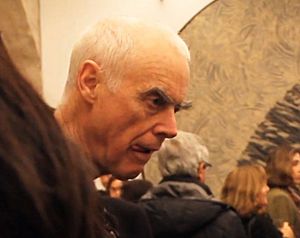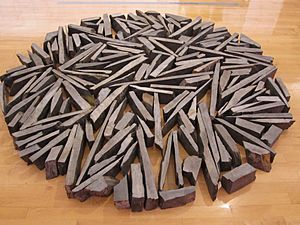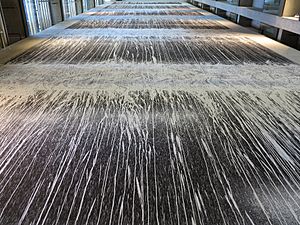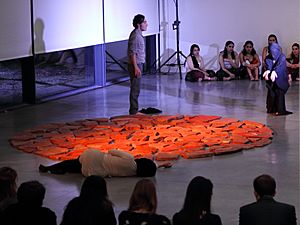Richard Long (artist) facts for kids
Quick facts for kids
Richard Long
|
|
|---|---|

Richard Long, March 11, 2015
|
|
| Born |
Richard Julian Long
2 June 1945 Bristol, England
|
| Education | Saint Martin's School of Art |
| Known for | Sculpture |
| Movement | Land Art |
| Awards |
|
Sir Richard Long, born on June 2, 1945, is a famous English artist. He is especially known for his unique style called Land Art. This means he creates art using natural materials found in the environment.
Richard Long has been recognized many times for his art. He was nominated for the important Turner Prize four times and won it in 1989 for his artwork called White Water Line. He was born in Bristol, England, and still lives and works there today.
He studied art at Saint Martin's School of Art. His artworks include sculptures, photographs, and even written descriptions. You can see his art in major galleries like the Tate in Britain and the Bristol City Museum and Art Gallery, as well as in museums around the world.
Richard Long's art has changed how people think about sculpture. He uses things like earth, rocks, mud, and stones. When his art is shown in galleries, it might be the actual natural materials themselves, or it could be photographs and notes about his outdoor art projects.
Contents
Early Life and Art Education
Richard Long was born in Bristol, a city in the southwest of England. He studied art at the West of England College of Art from 1962 to 1965. After that, he went to Saint Martin's School of Art in London from 1966 to 1968. There, he learned from famous artists like Anthony Caro. He also became good friends with another student, Hamish Fulton, who also became a well-known artist.
What is Richard Long's Art About?
Many of Richard Long's artworks are based on long walks he takes. He doesn't just make sculptures from natural materials; he also uses photographs, written descriptions, and maps of the places he has walked. He started taking these walks and making art from them in the mid-1960s. He has walked in many different places, from the Sahara Desert and Iceland to Australia and even near his home in Bristol.
His art has been very important because it changed how people see sculpture. Before him, sculpture was often thought of as being made from "traditional" materials like bronze or marble. Richard Long showed that art could be made from everyday natural things like rocks and earth. He also showed that the process of creating the art, like taking a walk, could be the artwork itself.
How Richard Long Creates Art
When Richard Long creates art in nature, he often changes the landscape in a small way. For example, in his famous piece A Line Made by Walking (1967), he simply walked back and forth in a field until his path created a visible line in the grass. Sometimes, he makes sculptures in the landscape using rocks or other materials he finds. He then takes photographs of these sculptures. Other times, his art is just a photograph or a map of a natural place, along with notes about where and when he took his walk.
One of his well-known pieces is Delabole Slate Circle, which is at the Bristol City Museum and Art Gallery. This artwork is almost 2 meters (about 6.5 feet) wide. It's made from 168 pieces of slate rock that came from a quarry in Cornwall, England. Richard Long has some rules for how the circle should be put together: all the pieces must touch each other to be stable, and they must form a perfect circle. This connection between the natural stones and the geometric shape shows a common idea in his art: the relationship between humans and nature. He explains that his work is "a balance between the patterns of nature and formalism of human, abstract ideas of lines and circles."


Where to See His Art
You can find Richard Long's permanent artworks in many places. For example, at Houghton Hall in Norfolk, England, there's a circle of Cornish slate in a mown path. The New Art Centre in Salisbury has his Tame Buzzard Line (2001), which is a line of flint stones.
Some of his large permanent installations include:
- Riverlines (2006) at the Hearst Tower in New York, USA. This was one of the biggest wall artworks he had ever made at the time.
- Planet Circle (1991) at the Museum de Pont in Tilburg, Netherlands.
- White Water Falls (2012) at the Garvan Institute in Sydney, Australia.
In 2009, a big show of his work called "Heaven and Earth" was held at the Tate Britain in London. In 2015, another important exhibition, "Richard Long: Time and Space," celebrated his art in his hometown of Bristol.
Walked-Line Artworks
Richard Long has created many artworks that are similar to his first piece, A Line Made by Walking. These pieces often involve him walking to create a shape or line in the landscape. Some are circles or winding paths. He has made these lines in snow, dust, and even by burning grass.
| Title | Location | Date | Description |
|---|---|---|---|
| Walking a Line in Peru | Peru | 1972 | A narrow path walked across a wide plain, leading to the foothills of distant mountains. |
| A Line and Tracks in Bolivia | Bolivia | 1981 | A path about 150 feet long. |
| Sea Level Waterline | Death Valley, California, US | 1982 | A path walked at the zero-foot level, showing where sea level would be in low-lying Death Valley. |
| A Line in Nepal | Nepal | 1983 | A forest path about 50 feet long. |
| Grass Circle- Ring of verde di Prato stone | Italy | 1985 | The artist created two artworks, one inside and one outside, that worked together. |
| Walking a Circle in Mist | Scotland | 1986 | A circular path about 75 feet wide; the outside of the path fades out like a halo. |
| Dusty Boots Line | The Sahara | 1988 | About 200 feet long; light dust is revealed under the dark surface rocks of the Sahara. |
| Whirlwind | The Sahara | 1988 | A spiral path about 75 feet wide, starting from a single point in the center. |
| Mahalakshmi Hill Line | Maharashtra, India | 2003 | A curving path about 100 feet long; chaff (waste from grain) was moved to show the dark earth underneath. |
| A Walking and Running Circle | Maharashtra, India | 2003 | A circular path about 15 feet across; created after a controlled grass burn. Long walked the path, and local children later ran on it. |
| Midday Muezzin Line | Siwa, Egypt | 2006 | About 200 feet long, one side of the path is very clear while the other side feathers out. |
| Tigerline | Switzerland | 2010 | About 300 feet long, following an existing footpath. A narrow central line was walked to show dark stone under snow. |
Books About Richard Long
Several books have been written about Richard Long's art and ideas:
- Nile (Papers of River Muds) (1990)
- South America (2012)
- Clarrie Wallis's book, Richard Long: Heaven and Earth (2009), was published with an exhibition of his photographs at the Tate Gallery in London.
Awards and Recognition
Richard Long has received many important awards for his contributions to art:
- 1976: Represented Britain at the Venice Biennale, a major international art exhibition in Italy.
- 1989: Won the Turner Prize in London, UK.
- 1990: Awarded the Chevalier de l’Ordre des Arts et des Lettres by the French Ministry of Culture.
- 2001: Became a member of the Royal Academy of Arts.
- 2009: Received the Praemium Imperiale for sculpture from Japan, a very prestigious international art award.
- 2015: Named Whitechapel Gallery Art Icon.
- 2023: Received the Wolf Prize in Arts.
He was also honored by the British government, becoming a Commander of the Order of the British Empire (CBE) in 2013 and a Knight Bachelor in 2018. This means he is now known as Sir Richard Long.
See also
 In Spanish: Richard Long para niños
In Spanish: Richard Long para niños
- Land art
- Environmental art
- Environmental sculpture



